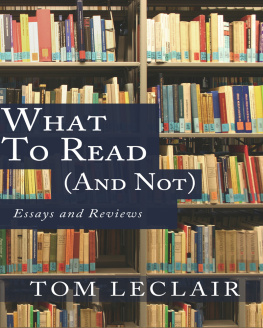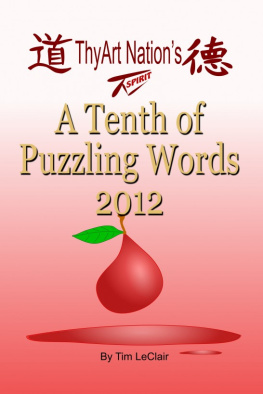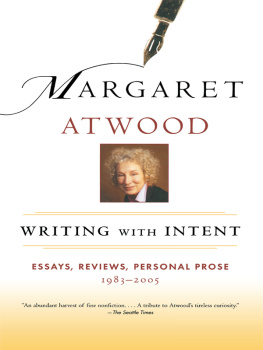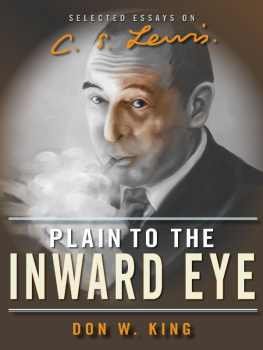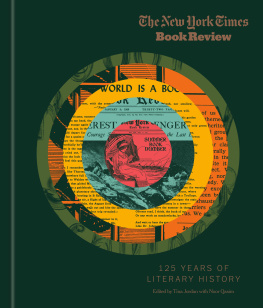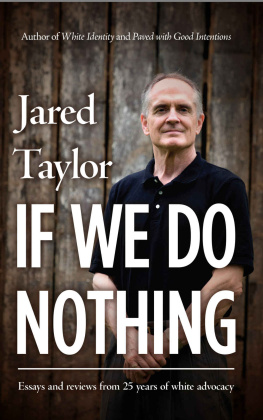What to Read (and Not): Essays and Reviews
By Tom LeClair
Dzanc Books
Praise of Tom LeClair
Tom LeClairs reviews are among the most thoughtful I have read and continue to read and among the most intelligent; they bring with them an experienced point-of-view and a seriousness of purpose equal to those of any reviewer in America. Harold Augenbraum, Director, National Book Foundation
Tom LeClair is a consistently reliable reviewer with the bona fides of a celebrated critic. As a reader who laments, So many books; so little time, I feel called upon to thank him virtually every month for reading the books I wont have to get. More important, a book that passes muster with Tom LeClair is a must read. Infallibly accurate and articulately focused, he provides an admirable service to the world of literary fiction.Neil D. Isaacs, author of more than twenty books and the forthcoming The Triumph of Artifice: Treasures of Twentieth-Century Narrative
While most review pages are weightlessdrawing together gauzy, breathless praise or mildly voiced dissatisfactionTom LeClair has spent forty years expanding the load-bearing capacity of the literary review to more accurately measure novelistic achievement. What to Read (and Not) crystallizes that project and lays out the contours for a new, more rigorously envisioned map of contemporary fiction. But while LeClair is one of the best guides to the territory, What to Read doesnt just tell you which landmarks to see and which to skip; this book is also a model of how to read: LeClairs reviews are a crash course in the physics of literature, equally comfortable tracing large intellectual investments as gauging a novels microfelicitiesdeftly decoding the shape of sentences, the hidden histories of words. Because it will sharpen your sense of what literature can do, and because LeClairs characteristic intelligence runs like a watermark through all these pieces, What to Read is a must read. Stephen J. Burn
Tom LeClair is one of our most perceptive readers of contemporary fiction. He has written about William Gass, William Gaddis, Don DeLillo, and Stanley Elkin, among others, with his own deep passion for difficult books. Jerome Charyn
What to Read (and Not): Essays and Reviews
By Tom LeClair
Dzanc Books
1334 Woodbourne Street
Westland, MI 48186
www.dzancbooks.org
Copyright 2013 Thomas LeClair
All rights reserved, except for brief quotations in critical articles or reviews. No part of this book may be reproduced in any manner without prior written permission from the publisher.
Published 2013 by Dzanc Books
A Dzanc Books rEprint Series Selection
Information on where these works were previously published can be found in the Acknowledgments.
Table of Contents
Introduction
What to read?
Book bloggers, social media, crowd sourcing, book tournaments, bookstore clerks, and Internet reviewers can offer recommendations, but if you prefer informed judgments by book critics, creative writers, or freelance reviewers your choices are narrowing. Review venues have gone out of business, and space for literary work is shrinking in magazines and newspapers that still try to cover books. Even the New York Times Book Review has seen its advertising revenues and pages plummet in the last few years. Online magazines such as Slate, Salon, Huffington Post, and the Daily Beast have tiptoed into the breach, but on the web only the Los Angeles Review of Books, the Electronic Book Review, and the Barnes and Noble Review are devoted solely to coverage of books.
Many of the essays and reviews in What to Read (and Not) appeared in those last two publications. Google up LeClair and the titles, and youll find the pieces for free. Ive brought them and others, some unavailable online, together here for a nominal charge to serve, I hope, as a convenient reference when next you ask yourself, What to read now? To be an occasional guide, I need, of course, to earn your trust, so sample my reviews of books youve already read to see if we agree on their merit or, if we disagree, to see if I make an interesting argument for or against the book in question.
In reprinting reviews, several of which go back beyond 2000, Im assuming there are readers who would rather learn about some of the best or most interesting works of fiction published in the last two decades than know about a book some flack or hack calls the best of last week. If you havent heard of a few books here, or you dont remember hearing of them, for you Ill be a discoverer, not just a guide. When people ask me not what but whom to read, I always say Richard Powers, the author of ten novels and, I think, the most important American fiction writer to emerge in this century. And yet few general readers recognize his name. His two best novelsThe Gold Bug Variations and Gainare discussed and maybe discovered for you here.
But this collection is not just a literary Zagats. Read together, the essays and reviews form a connected and consistent argument about what kinds of books are important and why. This argument is directed to general readers and to current and former students of literature who enjoy thinking about the cultural significance, as well as the quality, of the fiction we have. Piece by piece, review by essay, What to Read (and Not) is a commentary on the state of contemporary literary culture, the fiction division, the major works department, the office of originality, dissonance desk. The first five review-essays on recent National Book Award fiction finalists do not just measure the books against one another but also discuss issues surrounding the nominees, awards, and literary publishing in general. The Big Train and Historical Fiction traces the influence of Faulknerian grand ambition in 21st century novels. The Death and Life of Great New York Novels compares recent fiction about New York with big books of the 1970s and 1980s. False Pretenses, Parasites, and Monsters evaluates contemporary women rewriting older canonical men. Although most of the writers I consider are American, I have included reviews of three Canadians, two excellent young writers from BritainTom McCarthy and Hari Kunzruand reviews of better-known older British novelistsIan McEwan and Howard Jacobson. Also reviews of translated works by Orhan Pamuk, Mario Vargas Llosa, Milan Kundera, W. G. Sebald, and Daniel Kehlmann, an Austrian prodigy.
About that trust I mentioned earlier: book editors have been relying on me for almost four decades. Ive been reviewing regularly for the New York Times Book Review since 1975 and at various times for Saturday Review, Commonweal, The New Republic, The Nation, Atlantic, Bookforum, American Book Review, Washington Posts Book World, Kirkus, Salon, Los Angeles Review of Books, even USA Today. For several years I was a staff reviewer for the glossy Book Magazine, writing one 800-word review and two shorts every two months. Book World and Book Magazine are both defunct now, and like other critics Ive turned to digital venues Ive mentioned. I miss getting free subscriptions to the print magazines I used to write for, but Ive come to prefer online outlets, primarily because space on the Internet is cheap so Im allowedand readers receivemany more words than most tree-based publications can afford for book reviews. With all that free space, though, comes responsibility: to fill it with knowledge of all the writers work, not just the one being reviewed.
I got my start reviewing in 1974 when an editor at the Cincinnati Enquirer gave me a whole page to write about Joseph Hellers
Next page
